Here you can find:
The Mae Hong Son Loop is undoubtedly one of the best routes through Northern Thailand for those looking for adventure and alternative destinations. Sunsets over mountain landscapes, tribal markets in small villages, ancient Buddhist temples, scenic cafes, rice paddies… and endless miles of winding roads. This is the Mae Hong Son Loop.
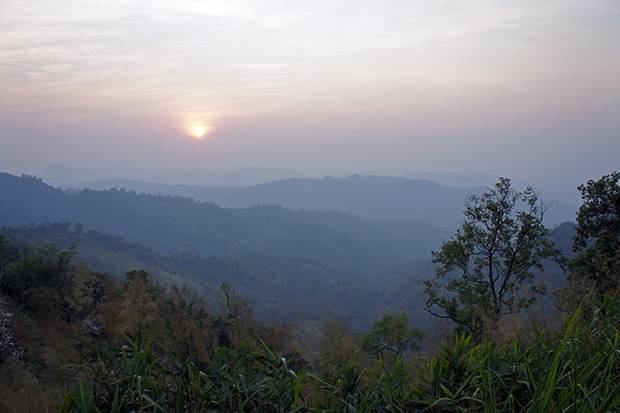
Mae Hong Son Loop is a nearly 700 km circular loop along a beautiful but dizzying road across the northern mountains, starting and ending in Chiang Mai city. Along the way, you will pass the backpacker village of Pai, the little-visited and almost Burmese town of Mae Hong Son, Doi Inthhanon National Park, where the highest peak in Thailand is located, and the village of Mae Sariang. All of these destinations are surrounded by dirt roads that are perfect for exploring by motorcycle, often leading to tribal villages, hot springs, waterfalls, caves and all sorts of places ideal for those looking for a bit of adventure.

🧘♀️ Mae Hong Soon Loop is in our opinion one of the 20 best experiences you can have in Thailand, find out the rest of things to do here!
A route for experienced drivers
Almost all of the 700 km of this route are winding mountain roads with ups and downs, so it is not without its dangers, in addition to being famous for causing motion sickness to almost all travelers. Therefore, it is not recommended to do this route by driving your own vehicle unless you have full confidence in your driving skills and some experience in driving in Thailand, especially if you decide to do it by motorcycle. The most dangerous time to travel this route is during the monsoon season, from May to October, when the roads are often wet and slippery.
The route can either be done counter-clockwise -start heading north from Chiang Mai to Pai- or clockwise -start heading southwest to Doi Inthanon-. It makes no difference, although the clockwise option is more popular. The complete route requires a minimum of 3 days, but the truth is that doing it in only 3 doesn’t make much sense, as you will not see much more than the road. I recommend doing it at least in a week, calmly, with time enough to enjoy the destinations you find along the way.
Mae Hong Son Loop in 5 stages
► Stage 1: From Chiang mai to Doi Inthanon (or to Mae Sariang)
Most people usually start by going directly to Mae Sariang. I recommend spending a night in Doi Inthanon National Park, either sleeping in their bungalows/tents, or in one of the surrounding hostels. The route is not complicated. From Chiang Mai, just drive southwest on Highway 108 until you reach Chom Thong town, and then take a detour north on Rd. 1009 to the Park’s entrance. In total 96 kms from Chiang Mai. Highway 108 is wide, straight and not heavily trafficked, while Rd. 1009 is a smaller and more interesting road. Entrance to the park costs 300 THB per person.
 What to see in Doi Inthanon?
What to see in Doi Inthanon?
Doi Inthanon has the highest peak in Thailand (2565 meters above sea level), which is accessed by road. Just before arriving, you’ll find the 2 famous pagodas, which make an amazing mountain viewpoint in clear days. Also on the way you will find two of the most impressive waterfalls in the Park: Wachirathan and Mae Klang. Here you have more information about Doi Inthanon National Park.
► Stage 2: From Doi Inthanon to Mae Sariang
If you stopped to sleep at Doi Inthanon, the second recommended stage would be to Mae Sariang. The route is simple: go back to Highway 108 and continue driving southwest until Mae Sariang. This section of road becomes more interesting and gets gradually greener. From now on vegetation will surround you until you return to Chiang Mai. If you have slept at Doi Inthanon National Park, in this second stage you will travel about 180 kms.
 What to see in Mae Sariang?
What to see in Mae Sariang?
Mae Sariang is a small town rarely visited due to its remote location, somewhat far from everything. It is a good place to hiking off the beaten path, visiting some authentic tribal villages. On the way, before arrivin to Mae Sariang, you will pass the highly recommended Mae Um Long Luang hot springs. Finding accommodation in Mae Sariang is easy.
► Stage 3: From Mae Sariang to Mae Hong Son
In this third stretch of 160 kms the real fun begins for the driver. The road becomes a continuum of ups, downs and curves, sometimes 180 degrees. The roads will remain this way until almost reaching Chiang Mai, at the very end of the route. Looking on the bright side, from this point on the traffic is reduced considerably. You will hardly find other cars, which is very appreciated especially if you are riding a motorcycle. Along the way you will come across some small villages where you can take a break and have a drink.
What to see in Mae Hong Son?
Mae Hong Son is a fairly large town located in the middle of a valley near the Burma border. The population in Mae Hong Son is made up of different ethnic groups, including Thais, Burmese, Shan and others.
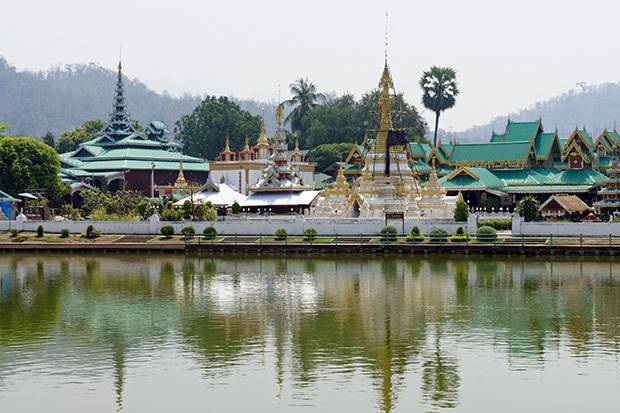 The town’s temples follow the Burmese architectonic style, with one of the most prominent being the beautiful Wat Chong Kham, with a photogenic lakeside location. Another temple that you can’t miss is Wat Phra That Doi Kong Mu, whose hilltop location offers great views over the entire area.
The town’s temples follow the Burmese architectonic style, with one of the most prominent being the beautiful Wat Chong Kham, with a photogenic lakeside location. Another temple that you can’t miss is Wat Phra That Doi Kong Mu, whose hilltop location offers great views over the entire area.
A few kilometers north of Mae Hong Son, on the way towards Pai, there are several interesting places worth visiting:
1) Su Tong Pae Bridge
A beautiful 500 meter long wooden bridge that crosses rice fields and a small river. Every morning around 6 o’clock, the monks from a nearby monastery cross it on their way to collect the morning alms. Every year at the end of July, in the days of the Khao Phansa celebration (end of Buddhist Lent) the bridge is beautifully illuminated at night. Its exact location is this.

 2) The Country Club
2) The Country Club
For 900 THB you can get a mud treatment at The Country Club. They give you a facial massage and cover your body with mud. After some time, they clean you and then you can relax in the thermal waters pool. Fun, relaxing and interesting! It is here.

 3) The small Tham Pla National Park
3) The small Tham Pla National Park
Most people don’t really visit the National Park, but only stop at the ‘Fish Cave’ that gives it its name, and just check out at the famous blue fishes that live there. The surrounding area is very beautiful, and there are a few paths that allow visitors to explore the forest a bit. This is Tham Pla location.
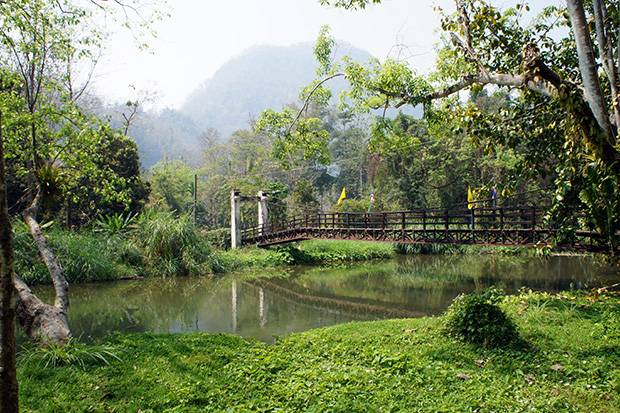
 Here you have more information about Mae Hong Son.
Here you have more information about Mae Hong Son.
► Stage 4: From Mae Hong Son to Pai
This stage is very cool in terms of landscape, and passes through some fairly large tribal villages, with weekly local markets that you’ll have the chance to visit if you are lucky. The road between Mae Hong Son and Pai is entirely made up of curves, so you have to be especially careful. On the way you will pass near Tham Lot Cave, the most famous cave in northern Thailand. If you have enough time it is worth stopping and visiting. You can even spend the night in one of the hostels you’ll find in the surroundings. I did it a few years ago, and it was great spending a couple of days there, visiting the cave and exploring the dirt roads that lead to tribal villages and hot springs.
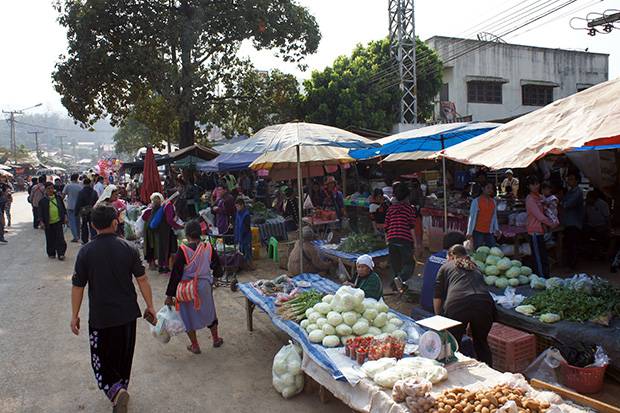 Another interesting place along the way, about 35 kms from Mae Hong Son, is Wat Tam Wua Forest Monastery. It is located in a spectacular green mountainous area, and they accept foreigners to join their Vipasana meditation programs, which last for several days. Some friends of us stayed there a few years back, and they completely loved the place and the experience.
Another interesting place along the way, about 35 kms from Mae Hong Son, is Wat Tam Wua Forest Monastery. It is located in a spectacular green mountainous area, and they accept foreigners to join their Vipasana meditation programs, which last for several days. Some friends of us stayed there a few years back, and they completely loved the place and the experience.
If you visit the monastery you will see foreigners dressed in white, sweeping the temple grounds or practicing meditation. If you are interested in joining their Vipasana programs you can do it for free, and they will provide you with accommodation and food. Donations at the end of the stay are appreciated.
 What to see in Pai?
What to see in Pai?
Pai is the most famous place on the entire route, the backpackers’ mecca of northern Thailand. An ideal destination for those seeking tranquility and cheap prices. The most popular activity in Pai is… well, just doing nothing. Just find a well-located bungalow with a good hammock where you can rest from the route and relax. But if you want some action, there are lots of interesting spots in the vicinity that could keep you busy for days.
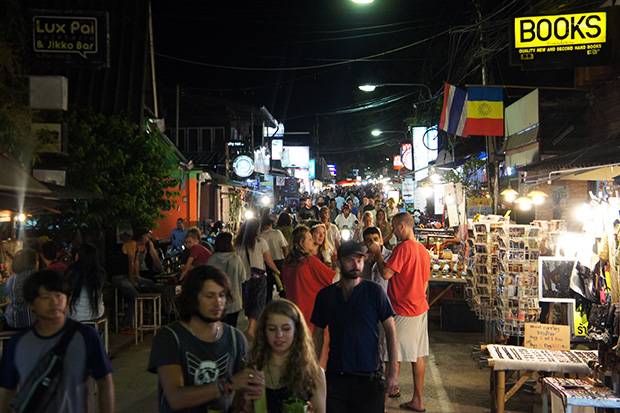
 The most famous spots in the area are a couple of waterfalls, Wat Klang and Chedi Phra That Mae Yen temples, and Pai Canyon, 6 kms out of town. Every evening there is a very cool Night Market on the main street. Here you have more information about Pai.
The most famous spots in the area are a couple of waterfalls, Wat Klang and Chedi Phra That Mae Yen temples, and Pai Canyon, 6 kms out of town. Every evening there is a very cool Night Market on the main street. Here you have more information about Pai.
► Stage 5: From Pai to Chiang Mai
This is the most famous stretch of road on the route. From Pai to Chiang Mai there are exactly 762 curves, along a road surrounded by forest and several interesting viewpoints. You’ll come across a few nice roadside cafes, such as the MeeMod Coffe Shop (Witches’ Cafe), perfect for a break. The road for this stage has been renovated, so it is in good condition. However, we must not lower our guard while driving, since there is also more traffic, so the risk remains high.
This is the last stage, so if you make it this far you will have completed the Mae Hong Son Loop. Congratulations! Just find yourself a good bar in Chiang Mai and celebrate with a cold Singha beer. You will have earned it.
🏍️ Where to rent the car or motorcycle for my Mae Hong Son Loop?
There are many motorcycle rental shops in Chiang Mai. If you are given the option, we recommend that you do not leave the passport as deposit, but an amount of money instead. If you rent a simple scooter, 3 or 4 thousand THB should be enough. The motorcycle rental usually costs between 120 and 200 THB a day, but can cost much more depending on the type of motorcycle you choose. Don’t forget to take photos of every scratch in the motorcycle the moment you rent it, so when you return it the shop cannot claim for damages previous to your rental.
If you prefer to rent a car, there are also several rental shops. I usually rent them from Journey Smile. When I did part of this route by car, they charged me 900 THB a day for a small automatic gear Honda, and they blocked 10,000 THB from my credit card as a deposit.
 📅 When to do the route?
📅 When to do the route?
The best dates are from November to April, just because it doesn’t rain, so the road is safer. During the months of December and January it can be a bit cold, while in April it is very hot. Anyway, if you feel like it, the route can be done all year round.
 👕 What kind of clothes to wear?
👕 What kind of clothes to wear?
If you go in December or January you will need warm clothes. For the rest of the year you will need, above all, summer clothes, although in the evenings it can get cool all year round. If you travel by motorcycle, it is recommended to wear long pants.
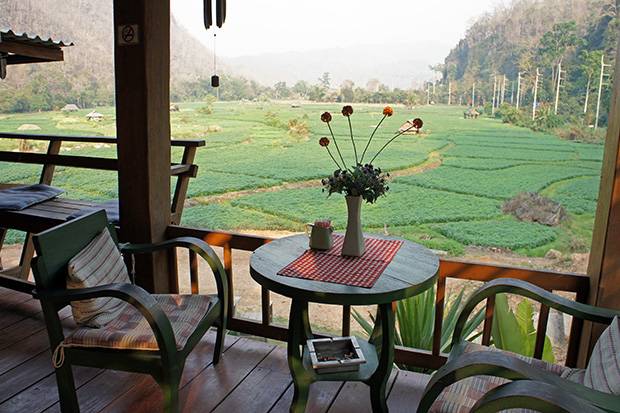 During the route we met a German couple on a long motorcycle journey. The funny thing is that they had German license plates. Here you can see the map of the amazing trip they were doing 😉
During the route we met a German couple on a long motorcycle journey. The funny thing is that they had German license plates. Here you can see the map of the amazing trip they were doing 😉






 What to see in Doi Inthanon?
What to see in Doi Inthanon? What to see in Mae Sariang?
What to see in Mae Sariang?
 2) The Country Club
2) The Country Club
 3) The small Tham Pla National Park
3) The small Tham Pla National Park What to see in Pai?
What to see in Pai? 📅 When to do the route?
📅 When to do the route?  👕 What kind of clothes to wear?
👕 What kind of clothes to wear? 

